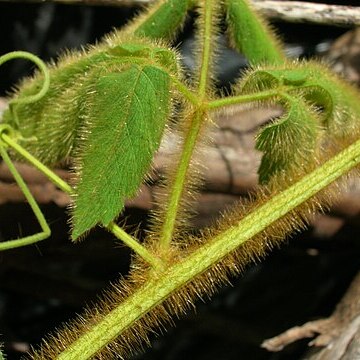Herbaceous or woody climbers, rarely shrubs. Leaves usually biternate or bitrilobate; stipules small, deciduous; leaflets pinnately lobed or dentate, usually with pellucid glands. Panicles axillary; peduncles rather long, first pair of branches forming tendrils or spines; bracts and bracteoles subulate. Flowers unisexual, zygomorphic, with slender noded pedicels. Sepals 4 or 5, imbricate, outer 2 smaller. Petals 4, with a large scale inside and slightly above base; scales of abaxial petals with broadly winged appendage, scales of adaxial petals simple. Disk lobed into 2 large glandular lobes at base of petals. Stamens (male flowers) 8, slightly longer than petals. Ovary (female flowers) ellipsoid, trigonous, 3-loculed; ovules 1 per locule, inserted at middle of middle axis; style short; stigma 3-lobed. Capsules inflated, saclike, 3-loculed; pericarp membranous or papery, veined. Seeds 1 per locule, subglobose; hilum cordate or suborbicular; embryo with large cotyledons, outer one arched, inner one reflexed. 2n = 20, 22.
Herbaceous tendrilled vines, or less often erect subshrubs, with woody base, not producing milky sap; stems furrowed, cylindrical or slightly angled; cross section with a single vascular cylinder. Leaves ternately or biternately compound, membranous or chartaceous; leaflets deeply serrate or lobed; petioles and rachis unwinged; stipules minute, early deciduous. Inflorescence a racemiform thyrse, with flowers in lateral cincinni, and often bearing a pair of tendrils at the base of the rachis. Flowers zygomorphic, functionally staminate or pistillate; calyx of 4 or 5 sepals; petals 4, distinct, white, with a hood-shaped appendage; nectary disk unilateral, 4-lobed or with 2 corniform projections; stamens 8, the filaments unequal, connate at base, the anthers dorsifixed; ovary 3-carpellate, each locule with a single ovule, the style slender, the stigmas 3, recurved. Fruit an inflated, membranous, capsule, the septa persistent after dehiscence of valves. Seeds spherical, black, with a small, white, cordate hilum.
Polygamous, herbaceous, annual or perennial vines; stems herbaceous to woody with axillary or peduncular tendrils. Leaves usually biternate, occasionally decompound or with a lesser number of leaflets, hispid to glabrous, often with pellucid dots or lines; stipules small, rarely wanting. Inflorescences axillary pani-cles. Flowers irregular; sepals 5, often with 2 sepals entirely connate, the outer 2 much smaller; petals 4, the scale on the inside of the petal with a bilobed crest and a deflexed barbate appendage; disc glands 4, the 2 superior ovate or cornute, the 2 inferior obsolete; stamens 8, eccentric, the filaments unequal, free or connate at the base; ovary trilocular, triquetrous, sessile or stipitate, the style filiform, the stigmas 3, the ovule solitary. Fruits capsular, 3-celled, inflated, obovate, sub-globose or turbinate, membranous or subchartaceous; seed globose, the funicle round, reniform or cordate, the embryo curved, the radicle short, the inner cotyle-don plicate.
Monoecious annual or sometimes perennial herbaceous or woody climbers, with ribbed stems, some species, including all those in Africa, climbing by means of tendrils. Leaves variously compound on a trifoliate basis: ternate with deeply 3-lobed leaflets, biternate or (not in Africa) many-times ternately compound or pinnate. Inflorescences axillary, each a branched thyrse; commonly with paired tendrils at the top of the peduncle, which may itself act as a tendril. Flowers slightly irregular; sepals (in Africa) 4, unequal; petals 4, each with a scale-like appendage directed away from the petal, together forming an additional perianth whorl; disk unilateral, extrastaminal, consisting of two variously-shaped glands. Male flowers with 8 dorsifixed stamens and minute pistillode. Female flower with 8 staminodes; ovary 3-celled, style trifid. Fruit an inflated capsule with 3, 1-seeded locules. Seeds black, globose, the hilum conspicuously white, covered when fresh by an aril.
Herbaceous climbers, monoecious; stems, leaf axes and peduncles usually ribbed. Leaves biternate, stipulate; leaflets with lamina lobed, pinnatifid, dentate or serrate, chartaceous. Inflorescence axillary; peduncle long, with 1 or 2 pairs of circinnate tendrils; branches usually with densely bracteate racemes or cymules towards apex; bracts small, subulate. Flowers unisexual. Sepals usually 2-paired; outer pair smaller, ovate, flat; inner ones elliptic, concave. Petals 2-paired, obovate; scales when present, oblong, cucullate; crests broad. Disc unilateral, 4-lobed; posterior lobes usually obsolete. Stamens 6–8, unilateral, opposite disc; filaments filiform. Ovary 3-locular; ovule 1 per locule; style short; stigma 3-lobed. Fruit loculicidally dehiscent, stalked, inflated; valves membranous. Seed globose, smooth, black; aril minute.
Sep 4, 2 large, 2 small; pet 4, somewhat unequal, each with an erect petaloid appendage at base; nectary-disk unilateral, biglandular; stamens 8; fr a bladdery-inflated, 3-locular and 3-lobed capsule; herbs, climbing by axillary tendrils, with ternate or biternate lvs and small, unisexual, white to red fls in small clusters, the long peduncle bearing tendrils near the fls. 14, mainly trop. Amer.
Petals 4, with scale-like appendages, those of the 2 posterior ones complex in form and sometimes joined to those of the anterior ones.
Inflorescence an axillary corymbose paniculate thyrse with a pair of coiled tendrils at the apex of the peduncle.
Disk unilateral, bearing posteriorly 2 glands and elongated anteriorly into a short androgynophore.
Annual or rarely perennial climbing herbs (sometimes slightly woody); stems longitudinally ridged.
Leaves usually stipulate, petiolate, biternately compound to apparently pinnate (in our area).
Stamens 8, free or slightly connate at the base; staminodes shorter in the female flowers.
Ovary 3-locular, loculi 1-ovulate; style 3-fid; pistillode vestigial in male flowers.
Flowers spuriously polygamo-dioecious, zygomorphic; bracts scale-like, minute.
Sepals 4, lateral ones small, anterior and posterior ones larger.
Seeds black, globose with a white ovate to reniform hilum.
Fruit an inflated membranous capsule.

